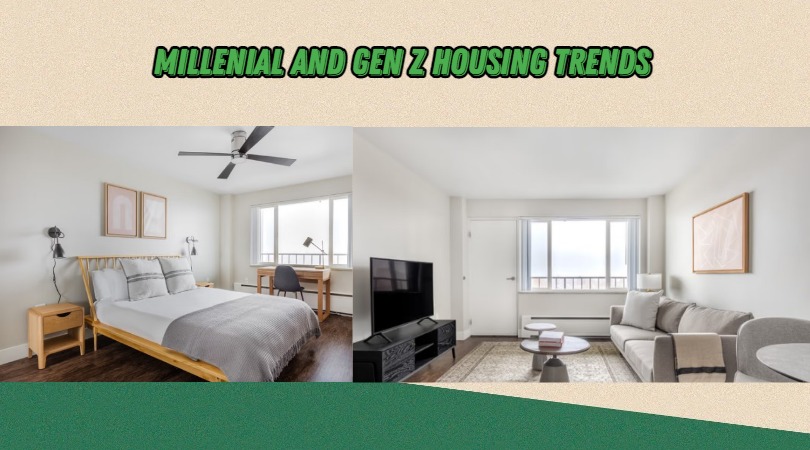
Tech-savvy, connected, environmentally and ethically conscientious; Millenial and Gen Z Housing share a lot in common when it comes to house preferences. But how do they differ from boomers’ preferred housing types?
Needless to say, younger generations seek some of the same things that older generations did, such as great location. But on top of that, they also look for modern elements that their parents didn’t. And their needs and desires go beyond the house features themselves.
Table of Contents
In today’s post, we’ll help you better target more high-paying tenants by exploring six ways Millenial and Gen Z Housing trends are different from the stereotypical house.
Small Houses:
Millennials and Gen Zers are more interested in smaller homes than baby boomers. The reason for this is two-fold. And the first is the limited budget.
Younger generations are burdened with debt and don’t have enough money to splurge on a bigger house like previous generations did. From soaring college costs to paltry wage growth, many today face economic circumstances much different from the generations before.
About 1 in 5 Americans graduate from college with substantial student loans, the survey found. And because large, ornate homes tend to cost more, naturally, with limited budgets, younger generations have had to scout for small, flexible, and personalized homes.
Another reason is that millennials and Gen Zers get married much later in life, and when they do, have fewer children or none at all.
According to the Census, the number of individuals aged 30-34 years and lacking children at home rose by 4% from 2011 to 2015. The smaller families have greatly reduced their need for bigger houses.
Modern Amenities:
While millennials and Gen Zers aren’t concerned about a big space, modern, high-functioning amenities make up a big part of their lives. And that means they love amenities like dishwashers, washers and dryers, updated bathroom fixtures, things that you usually find in a furnished rental rather than on a vacant property.
A study conducted by the National Association of Home Builders found that more than 80% of both generations want things like smart toilets, wall-mounted vanity, freestanding tubs, and more.
Home automation is another focus for the fast-growing cohort of young home seekers eager to snag their next dream home. Many are constantly on the lookout for ways to interact with their homes just as they would with their smartphones.
Smart home setups such as smart locks, video doorbells and automated security cameras pique the interest of these two generations.
Ideal Location:
The practicality of location and neighborhood matters to millennials and Gen Zers. They are attracted to great communities that not only offer a flexible work-life balance but also fit their personalities and lifestyles.
For these generations, good schools for children or quiet suburban neighborhoods aren’t as big of a concern. Their ideal location has to be close to work or public transport routes to cut down on commuting time. If there are bike paths leading to work, many feel that’s the ideal location.
Folks in their 30s and 20s also prefer to live where the “action” is. So if your apartment is a few minutes’ walk from trendy bars and cafes, shopping and entertainment centers, make the most of it.
Reliable Internet:
Nothing can separate millennials and Gen Zers from their technology. Both generations are racially diverse, more educated, and more technology driven than earlier generations.
What this means is that internet access shouldn’t be an issue if you’re to attract these generations. When it comes to the internet, you need to focus on speed and reliability. They should be able to work from home or settle down to watch Netflix without instances of network lags.
Consider upgrading from cable internet to fiber-optic cable to create a place where these younger, more tech-savvy generations will feel right at home. With speeds approaching the speed of light (up to 2,000 mbps), your potential tenants will experience no problem accessing the internet.
Green Living:
As a whole, millennials and Gen Zers value the environment and green living. Reducing the carbon footprint is one of their main priorities. Therefore, homes with energy-saving and environmentally-friendly amenities will naturally appeal to both generations.
Energy-saving light bulbs, water-saving shower heads, low flow toilets and other green features can make a world of difference in reducing a home’s negative environmental impacts and overall energy consumption. Appliances like dishwashers, washer-dryers, and refrigerators should also boast the U.S. EPA Energy Star rating.
To put it simply, if you’re revamping your rental property to attract the younger generation, make sure to include any energy-saving and environmentally-friendly feature you can think of.
Multifunctional Spaces:
We’re seeing a new trend where younger individuals are pursuing interior layouts that can easily serve multiple purposes. Young folks want homes that can be used for both social and practical purposes.
Multifunctional spaces enable them to interact casually with their friends without being confined in one particular room. The option to move around the entire house and entertain casually catches the attention of most young people. When prepping your home for millennial and Gen Z renters, focus on the home’s versatility.
Of course, you don’t necessarily need to bring down a wall to create an extra floor space. For smaller apartments and condos, creativity is vital. Exercise equipment can be tucked away in a bedroom corner, a hammock can share space with a dining room, and so on.
Conclusion:
With millennials and Gen Z making up the largest share of house renters, it’s a good idea to make your property responsive to their demands to attract and keep them.
Planning to rent out your home to millennials and Gen Zers? We’d love to hear your experiences and any feedback you might have.
Visit for More Best Articles